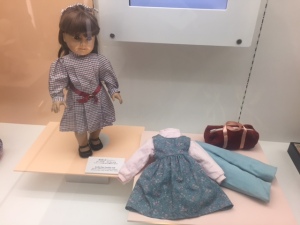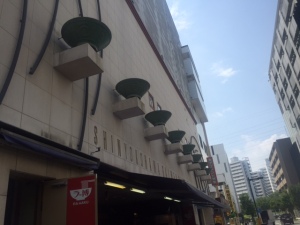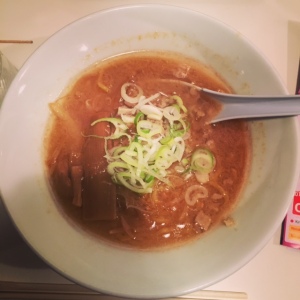During the summer, I took another day trip to the Yokohama Doll Museum. It’s a small museum, and doesn’t take more than 45 minutes to go through, though I lingered a little longer in the air conditioning.
The entrance is actually on the second floor of the building, and the entrance fee is very cheap, only 400 yen for adults.
The first doll to greet you is a doll that was given to the city of Yokohama from America, as a symbol of good will and International friendship. She even has her own passport. As you go walk further, you will see more dolls that were exchanged between Japan and the USA over the years. One of the dolls exchanged is actually an American Girl Doll, Samantha, but for some reason, the label next to her says her name is Jessica. I’m guessing that a little girl decided to change the name of the doll before sending her over to Japan.
The next room showcases different dolls from around the world, and are organized by European, African, Latin, Asian, and North American dolls. They also had some music playing in the background. I was amused that one of the background songs included bagpipes, even though there wasn’t a single Scottish doll on display. I didn’t take too many photos, because I actually wasn’t sure if photos were allowed or not, so I snapped some quick photos when no one was looking.
You continue through the museum by going upstairs, and as you walk upstairs, there is a timeline of the types of dolls and figures that were popular in Japan from the early 1900’s all the way to the early 2000’s. On the third floor, there is a display showing the differences between the dolls in Japan and Europe, and even displays of different doll houses and accessories from Japan and Europe. I love seeing the dollhouse displays and seeing all of the different tiny accessories.
They also had a display on the steps to making a bisque doll, versus making a traditional Japanese doll. Sadly, I didn’t take any photos of this display, but it was certainly fascinating. It made me wish that I knew how to build dolls.
If you go back down one floor, there is a special exhibition room for seasonal displays. The seasonal display they had when I visited was about a Japanese puppet artist’s production of Sherlock Holmes. There was definitely no photos allowed in this room. To be honest, I was not super impressed. This puppet artist basically based his puppets off of some manga artist’s rendition of Sherlock Holmes, and then gave all of the puppets blue and green skin. It was kind of creative, but the Sherlock and Watson puppets looked nothing like Sherlock and Watson.
Since it didn’t take long to go through, I took a stroll along Yamashita park, which is literally right across the street from the Doll Museum. I found the Girl Scout statue in Yamashita park, which shows an American and a Japanese Girl Scout joining hands in friendship.
After strolling through the park, I stumbled and found the Yokohama Customs museum. I wasn’t super interested, until I saw a sign saying that admission was free, and I wasn’t going to say no free air conditioning. The Yokohama Customs museum even had it’s own mascot outside!
The museum was super tiny, but a fun little surprise. The first displays talk about how Yokohama first opened up to merchant ships soon after Japan opened its borders after Commodore Perry’s arrival, and how Yokohama had to quickly form a group to inspect and record all of the goods coming in and leaving Yokohama on merchant ships. It seems kind of boring at first, but just around the corner from the boring history plaques, and copies of Meiji era customs forms, is a display of all kinds of confiscated contraband seized by customs officers in the last 20 years, including counterfeit designer bags, and products made from endangered animals. There is even a display showing how someone tried to smuggle a large amount of cocaine into Japan on a cargo ship.
After walking around this mini-museum, I took the train all the way back to Saitama. Having a low-key summer vacation, it was a good time to explore around Yokohama, and see a bunch of small sights not far from where I live.
This is all that I’m going to cover for my summer break. Next up, I’ll be writing about my last Inagakuen Culture Festival and Sports day. Hopefully I’ll have my September events caught up before Halloween comes!













